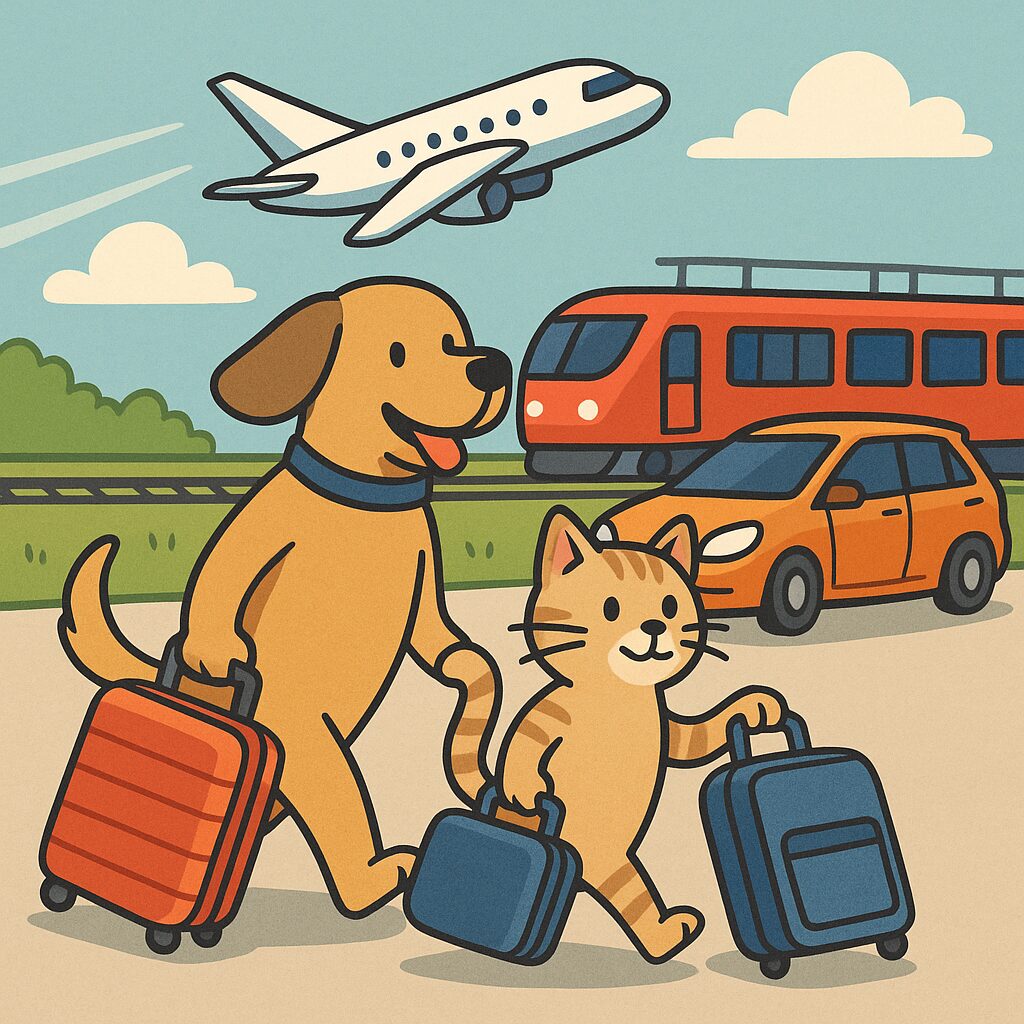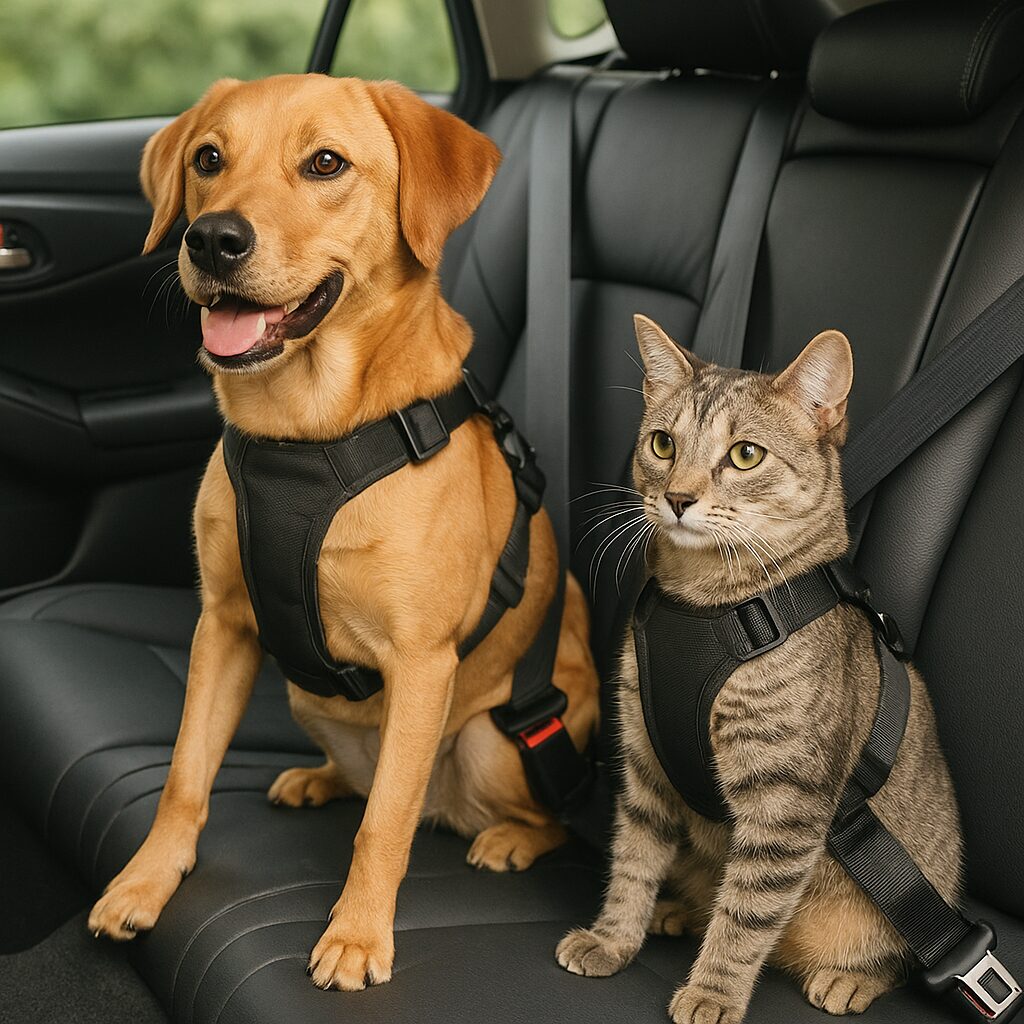
Ultimate Pet Travel Safety Guide
Traveling with pets has become more common than ever. Whether you’re heading out for a weekend road trip, flying across the country, or preparing for an international adventure, your pet’s comfort and safety should always come first. This pet travel safety guide walks you through everything you need to know to ensure a smooth, stress-free journey—no matter how near or far.
From dog travel safety basics to airline pet travel rules to packing checklists, this blog covers the key steps every pet owner should take before hitting the road (or sky) with their furry friend.
________________________________________
🚗 Car Travel With Pets: Keeping Dogs & Cats Safe on the Road
Car travel is the most common way people travel with pets, yet many pet owners don’t realize how unsafe it can be if a pet isn’t properly secured. In an accident, even a small pet can be thrown forward with tremendous force. That’s why safe pet transportation starts with the right restraint system.
Use Crash-Tested Pet Restraints
For dogs, the safest options include:
- A crash-tested dog travel harness
- A dog car seat belt tether
- A secured dog crate that’s strapped in
For cats, a sturdy, well-ventilated cat carrier is essential. Cats should never roam freely in a moving car—they can get under foot, jump onto the dashboard, or panic unexpectedly.
The Back Seat Is the Safest Place
Many people don’t realize that if your pet sits in the front seat, even a minor collision can deploy the airbag and seriously injure them. The back seat is always safest for both cats and dogs.
Never Leave Pets Alone in a Parked Car
This is one of the most crucial pet travel safety tips. Temperatures inside a parked vehicle can rise or fall quickly, even with cracked windows. Pets can suffer heatstroke in minutes—or experience dangerously cold conditions in winter.
Plan for Frequent Breaks
Pets need regular bathroom breaks, water, and stretch time. On long drives, stop every 2–3 hours. This helps reduce anxiety and keeps your pet comfortable and hydrated.
Keep Heads Inside the Vehicle
As cute as it looks, letting your dog hang their head out the window is unsafe. Debris can injure their eyes or face, and sudden stops can throw them forward.

________________________________________
✈️ Airline Pet Travel Safety: What You Must Know Before Flying
Flying with pets requires careful planning. Airlines have strict rules, and depending on your pet’s size, they may need to travel in cargo, which comes with additional risks.
Cabin vs. Cargo Travel
- Small pets (typically under 15–20 lbs) can fly in the cabin in an airline-approved pet carrier that fits under the seat.
- Large pets must fly in cargo. This option requires extra preparation because temperature, ventilation, and handling vary by airline.
Before choosing an airline, research their pet travel safety history, customer reviews, and specific pet policies.
Use the Right Carrier
Your carrier should be:
- Airline-approved
- Well-ventilated
- Labelled with your name and contact info
- Lined with absorbent material
A comfortable carrier can significantly reduce travel anxiety for both cats and dogs.
Know the Pet Travel Document Requirements
Most airlines require:
- A health certificate issued by your veterinarian
- Proof of up-to-date vaccinations
- Information about microchipping (especially for international flights)
These documents ensure your pet is healthy enough to travel and meets regional regulations.
Avoid Sedatives During Air Travel
Vets typically warn against sedating pets for flights because sedatives can cause breathing issues or disorientation, especially in high-altitude environments. If your pet has anxiety, ask your vet about non-sedative calming options.

___________________________________
🚉 Train, Bus & Ferry Travel With Pets
Pet policies vary widely across transportation companies:
- Some trains allow pets only in carriers.
- Many buses restrict pet travel except for service animals.
- Ferries often have designated pet areas or onboard kennels.
Wherever you’re traveling, always review the provider’s pet policy in advance to avoid surprises.
For these types of travel:
- Keep dogs leashed when allowed outside carriers.
- Bring a comfortable blanket or familiar toy to help your pet feel secure.
- Offer water regularly, especially on warm days.
________________________________________
🧳 Pet Travel Safety Checklist: What to Pack for Your Trip
Preparation is key to safe and stress-free pet travel. Here’s a comprehensive packing list to keep your pet comfortable:
- ID tags and microchip information
- Food and collapsible bowls
- Fresh water
- Medications and vet records
- Waste bags or litter supplies
- Blanket, toy, or comfort item
- First-aid kit
- A recent photo of your pet in case they get lost
These essentials ensure you’re prepared for emergencies and help maintain your pet’s routine while traveling.
________________________________________
🐕🦺 How to Keep Pets Calm During Travel
Travel can be stressful for even the most confident pets. Whether you’re dealing with a nervous dog or a timid cat, there are ways to make the experience easier.
Reduce Anxiety Before Traveling
- Take your dog or cat on short car rides before long trips.
- Get them used to their carrier by leaving it open at home with treats inside.
- Use familiar smells—like a favourite blanket—to help soothe them.
Vet-Approved Calming Options
Your vet may recommend:
- Herbal calming chews
- Pheromone sprays
- Anxiety vests
- Prescription solutions (non-sedative)
Talk to your veterinarian about the safest option for your pet.
________________________________________
🌎 International Pet Travel Safety Requirements
International travel requires the most preparation. Depending on your destination, you may need:
- An ISO-compliant microchip
- Rabies vaccinations or boosters
- A country-specific health certificate
- Import permits
- Possible quarantine upon arrival
These regulations vary widely, so start preparing 2–4 months ahead of time.
________________________________________
🎯 Final Thoughts: Safe, Stress-Free Pet Travel Is Possible
Traveling with pets doesn’t have to be overwhelming. With the right preparation, proper safety equipment, and knowledge of transportation rules, you can ensure a comfortable and safe journey for your furry companion. Whether you’re planning a cross-country road trip, flying across the world, or visiting family nearby, following these pet travel safety tips will help your dog or cat stay happy, healthy, and relaxed throughout your travels.
We provide animal health care certificates – get in touch with us to book an appointment.
